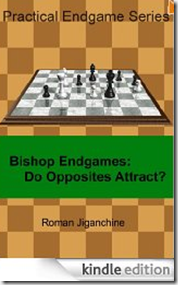I have made quite a few videos about the Spanish Opening, and wrote an eBook “Spanish Opening - Strategy and Tactics” about it that will give you a brief introduction to the Spanish from the White perspective. To give an overall map/overview to the various variations and to show how my videos fit together, I created this guide with diagrams and links to my videos. Now you can quickly find the video for the variation that you are interested in!
Spanish Opening - Overview
1. e4 e5 2. Nf3 Nc6 3. Bb5
- This move characterizes the Spanish Opening.
3. ... a6 4. Ba4 Nf6 5. O-O
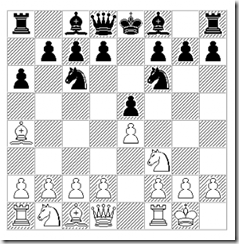 Black's first big decision is on move 5, he can choose between the classical lines, and the two sharp alternatives - the Moeller Variation, and the Open Variation.
Black's first big decision is on move 5, he can choose between the classical lines, and the two sharp alternatives - the Moeller Variation, and the Open Variation.
5. ... Be7
- ( 5. ... Nxe4 This is the Open variation where Black accepts the challenge and takes the unprotected pawn. 6. d4 b5 7. Bb3 d5 8. dxe5 Be6
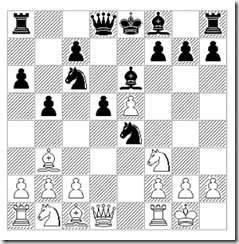 In the Open Variation Black also obtains active piece placement, but here he pays for it with pawn weaknesses. Regardless of whether the game opens up, or the pawn structure becomes fixed - Black will have some difficulties equalizing, as both sample games illustrate: 9. Nbd2 Nc5 10. c3 d4
In the Open Variation Black also obtains active piece placement, but here he pays for it with pawn weaknesses. Regardless of whether the game opens up, or the pawn structure becomes fixed - Black will have some difficulties equalizing, as both sample games illustrate: 9. Nbd2 Nc5 10. c3 d4 - ( It is a common mistake to exchange the white bishop too soon, as the following game illustrates: 10. ... Nxb3?! 11. Nxb3 Be7 12. Nfd4! Nxd4 13. cxd4 O-O 14. Be3 Rc8 15. Rc1 c6 16. Nc5 Bxc5 17. Rxc5 a5 18. Qc2 Bd7 19. f4 f5 20. Rf3 Qe7 21. Bd2 a4 22. Bb4 and White exerted strong pressure in Jiganchine,R-Trotchanovich,P/ Keres 2007, 1-0 )
- 11. Bxe6 Nxe6 12. cxd4 Ncxd4 13. a4! Be7 14. Nxd4 Nxd4 15. Ne4 Ne6 16. Be3 O-O 17. f4 and White won in Karpov,A-Korchnoi,V/Merano 1981 )
- ( 5. ... b5 6. Bb3 Bc5
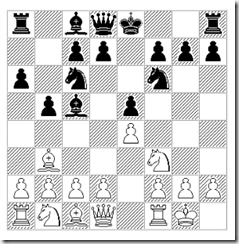
- This is the Moeller - Black develops the bishop to an active position, where it can become a target. The bishop will also be missing on the d8-h4 diagonal, so White's tries for advantage involve Bg5, as the sample game shows: 7. a4 Rb8 8. axb5 axb5 9. c3 d6 10. d4 Bb6 11. h3 O-O 12. Re1 Bb7 13. Na3 exd4 14. cxd4 Na5 15. Bc2 b4 16. Nb1 c5 17. Bg5 h6 18. Bh4 b3 19. Bxb3 g5 20. Nxg5 hxg5 21. Bxg5 and White had a strong attack in Hracek,Z-Shirov,A/Germany 1997, 1-0 )
6. Re1 b5 7. Bb3 d6 8. c3 O-O 9. h3 Na5
- ( 9. ... Bb7 10. d4 Re8 11. Nbd2 Bf8
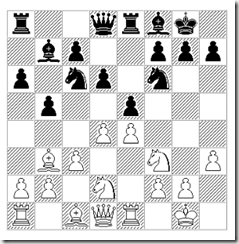 This is the Zaitsev variation where Black puts a lot of pressure on the 'e4' pawn; against this I recommend shutting down the center on move 12 with d4-d5. When Black undermines it by c7-c6 - White plays for occupying the d5 square, or tries to use the power of his bishop on the a2-g8 diagonal. 12. d5 Nb8 13. Nf1 Nbd7 14. N3h2 Nc5 (Allowing the white bishop to remain on b3 is rather dangerous: 14. ... c6 15. dxc6 Bxc6 16. Bg5 Qc7 17. Qf3 Qb7 18. Ng3 d5 19. Ng4 dxe4 20. Qf5 with attack in Kovacevic, A-Gligoric,S/Niksic 1997, 1-0 )
This is the Zaitsev variation where Black puts a lot of pressure on the 'e4' pawn; against this I recommend shutting down the center on move 12 with d4-d5. When Black undermines it by c7-c6 - White plays for occupying the d5 square, or tries to use the power of his bishop on the a2-g8 diagonal. 12. d5 Nb8 13. Nf1 Nbd7 14. N3h2 Nc5 (Allowing the white bishop to remain on b3 is rather dangerous: 14. ... c6 15. dxc6 Bxc6 16. Bg5 Qc7 17. Qf3 Qb7 18. Ng3 d5 19. Ng4 dxe4 20. Qf5 with attack in Kovacevic, A-Gligoric,S/Niksic 1997, 1-0 ) - 15. Bc2 c6 16. b4 Ncd7 17. dxc6 Bxc6 and White started to fight for the 'd5' square in Anand,V-Kasimdzhanov,R/Mainz 2007, 1-0 )
10. Bc2 c5 11. d4 Qc7 12. Nbd2
12. ... Nc6
- ( 12. ... cxd4 is the main line, immediately initiating play along the 'c' file. 12...Bd7 is the most popular alternative. 13. cxd4 Bb7 14. d5 Rac8 15. Bd3 Nd7 16. Nf1 Nc5 17. Ng3 Nxd3 18. Qxd3 Qc2? 19. Qxc2 Rxc2 20. Nf5 Re8 21. b3 Bc8 22. Nxe7+ Rxe7 23. Be3 Nb7 24. Bb6 Re8 25. Rec1 Re2 26. Rc7
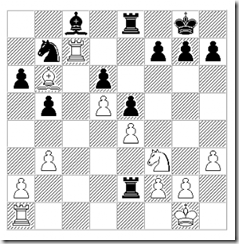 and White won due to his domination on the 'c' file in Aseev,K-Sturua,Z/Lvov 1985, 1-0)
and White won due to his domination on the 'c' file in Aseev,K-Sturua,Z/Lvov 1985, 1-0) - ( 12. ... Bd7 Temporarily maintains tension in the center. 13. Nf1 Rfe8
- ( 13. ... cxd4 14. cxd4 Rac8 15. Ne3 Nc6 16. d5 Nb4 17. Bb1 a5 18. a3 Na6 19. b4 g6 20. Bd2 axb4 21. axb4 Qb7 22. Bd3 Nc7 23. Nc2 Nh5 24. Be3 Ra8 25. Qd2 1-0 Tal,M-Hjartarson,J/ Reykjavik 1987, 1-0 )
- 14. Ne3 g6 15. dxe5 dxe5 16. Nh2 Rad8 17. Qf3 Be6 18. Nhg4 Nxg4 19. hxg4 Qc6 20. g5 Nc4 21. Ng4 Bxg4 22. Qxg4 f6?! 23. gxf6 Bxf6 24. a4 +/- Fischer - Unzicker, 1959, 1-0 )
- ( 12. ... Bd7 Temporarily maintains tension in the center. 13. Nf1 Rfe8
13. d5 Nd8 14. a4 Rb8
15. axb5
- ( 15. b4 is Geller's interpretation of this line: previously White would first exchange on b5, but that would give Black a better chance of fighting for the 'a' file. 15. ... c4 16. Nf1 Ne8 17. axb5 axb5 18. N3h2 +=
- ( 18. Ng3 g6 19. Nh2 Ng7 20. Rf1 Bd7?! 21. f4 Bh4 22. Qf3 f5 23. fxe5 dxe5 24. exf5 Bxg3 25. Qxg3 Nxf5 26. Qf2 Nb7 27. Ng4 h5 28. Ra6! hxg4 29. Rxg6+ Ng7 30. Rxg7+ and Black was mated in Nunn,J-Short,N/Brussels 1986, 1-0 )
- 18. ... f5? 19. exf5 Bxf5 20. Bxf5 Rxf5 21. Be3 Rf8 22. Nf3 +/- Geller,E-Smyslov,V/Palma de Mallorca, 1970, 1-0 )
- ( 18. Ng3 g6 19. Nh2 Ng7 20. Rf1 Bd7?! 21. f4 Bh4 22. Qf3 f5 23. fxe5 dxe5 24. exf5 Bxg3 25. Qxg3 Nxf5 26. Qf2 Nb7 27. Ng4 h5 28. Ra6! hxg4 29. Rxg6+ Ng7 30. Rxg7+ and Black was mated in Nunn,J-Short,N/Brussels 1986, 1-0 )
15. ... axb5 16. b4 Nb7 17. Nf1 Bd7 18. Be3 Ra8 19. Qd2 Rfc8 20. Bd3 g6 21. Ng3 Bf8 22. Ra2 c4 23. Bb1 Qd8 24. Ba7 Ne8 25. Bc2 Nc7 26. Rea1 Qe7 27. Bb1 Be8 28. Ne2 Nd8 29. Nh2 Bg7 30. f4 f6 31. f5 g5 32. Bc2 Bf7 33. Ng3 Nb7 34. Bd1 h6 35. Bh5
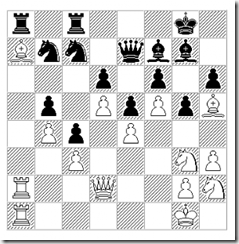 with a dominating position for White in Karpov,A-Unzicker,W, Nice 1974
with a dominating position for White in Karpov,A-Unzicker,W, Nice 1974
1-0
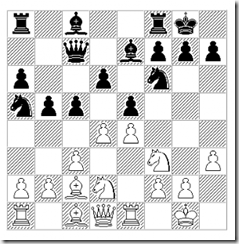
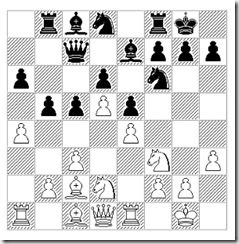
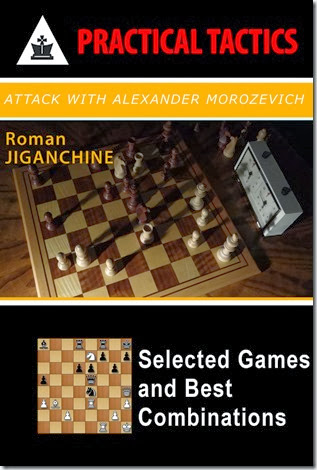
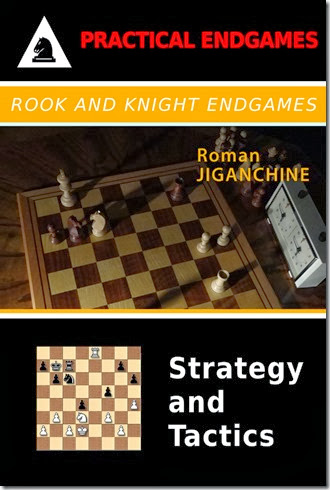

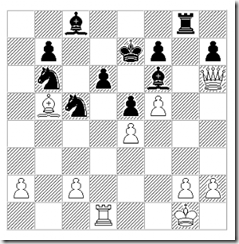
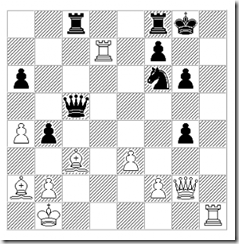
![209[1] 209[1]](http://lh3.ggpht.com/-zY2VZqq_L-Y/UXtNs9048zI/AAAAAAAADUQ/SfeIPvNgIk8/2091_thumb.png?imgmax=800)
![210[1] 210[1]](http://lh3.ggpht.com/-lQojmfEGJ6Q/UXtNueR6vgI/AAAAAAAADUg/GPeBGj0ZXEo/2101_thumb.png?imgmax=800)

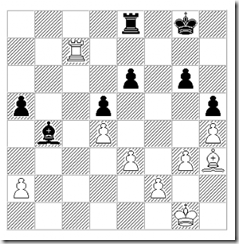
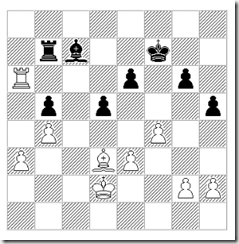


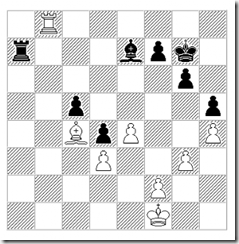
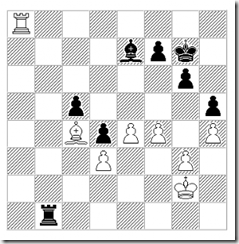
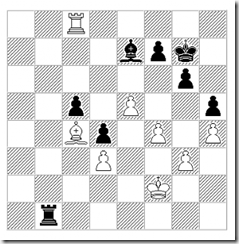
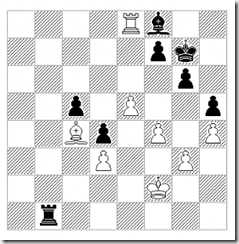
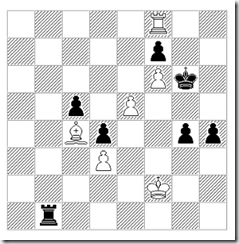
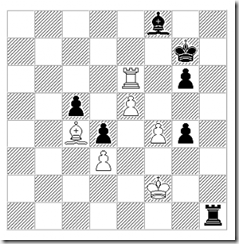
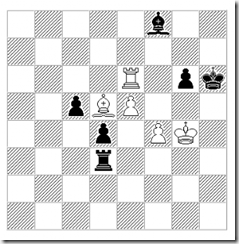

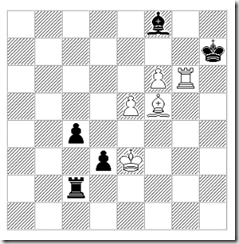
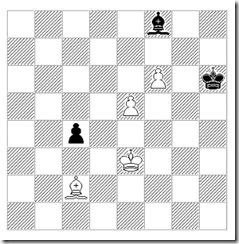
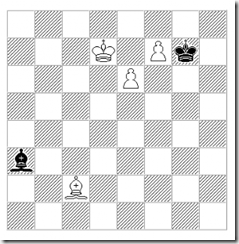


![207[1] 207[1]](http://lh4.ggpht.com/-pIIWvVDy2ls/UXtOBJ6gTQI/AAAAAAAADVA/adIF8wljdcA/2071_thumb.png?imgmax=800)
![208[1] 208[1]](http://lh6.ggpht.com/-PauLHEOjMPs/UXtOCInefrI/AAAAAAAADVQ/3VcbNj8riSQ/2081_thumb.png?imgmax=800)

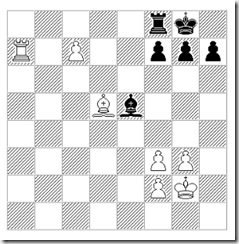
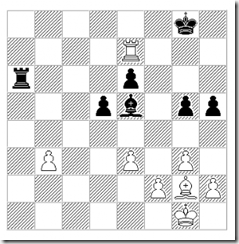




![66[1] 66[1]](http://lh5.ggpht.com/--bC-2wfiwc4/UXtI5ejApwI/AAAAAAAADTA/Jz7wrtFvgTE/661_thumb.png?imgmax=800)
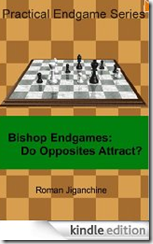
![66[6] 66[6]](http://lh5.ggpht.com/-WQGWRFAPdWo/UXtIjOiBBrI/AAAAAAAADSo/cGzHVVsjYas/666_thumb.png?imgmax=800)
